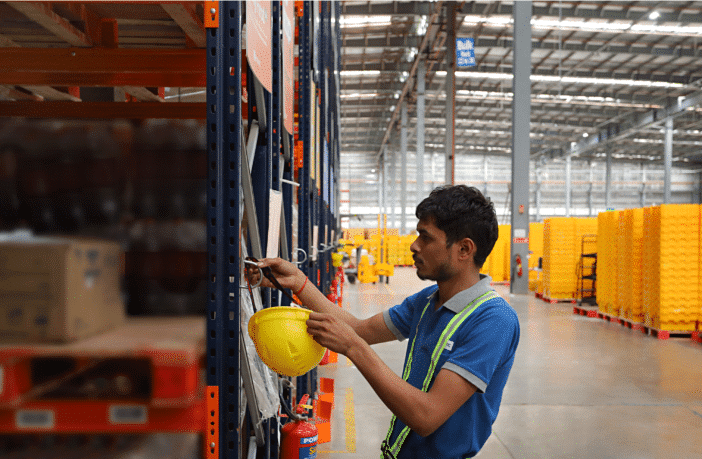Grade A warehousing: the preferred choice?
Organised developers in India are increasingly investing in Grade A warehouses : discover all the advantages of Grade A warehousing.
On June 22, 2021

Organised developers in India are increasingly investing in Grade A warehouses : discover all the advantages of Grade A warehousing.
On June 22, 2021
An integral part of the logistics and supply chain, warehousing is crucial to storage and movement of goods in a streamlined and efficient manner. Favourable reforms, infrastructure status to the logistics sector, GST implementation coupled with 100% FDI permits, have augmented the growth of logistics and warehousing space in India. Sectors like e-commerce, retail, pharmaceuticals, FMCG, manufacturing are fuelling the development of the market. India’s warehousing market is expected to grow to $19.5 billion by 2025. (Source: Research and Markets).
The pandemic acted as a catalyst for the ecommerce boom and increased warehousing space demand in Tier 2 and Tier 3 cities. These demands were mostly catered to by a mix of Grade A, B and C warehouses (predominantly by B & C grade warehouses). Normally, distinction between the quality of warehouses is based on their construction quality, amenities, automation, location and clientele. As the economy bounces back, the warehousing sector is the answer to minimal operational disruption and business continuity for companies. Companies are looking for cost-effective logistics and solutions that cater to better facilities and automation for a seamless supply chain. A visible change in terms of development pattern, preference of the warehouse occupants, funding, technology, rent is evident across the sector.
Firstly, organised developers in India are increasingly investing in Grade A warehouse infrastructure, which is comparable to their international counterparts. These warehouses offer extra height, floor load and high performance flooring systems. They have access to mechanised MHEs, fire safety protocols and a clean environment. They provide ample space for visitor parking, sufficient docking stations, MHEs/heavy vehicle movement as well as multi-modal connection amongst other facilities.
Grade A warehouses offer tangible benefits. For example, 50% additional floor-load capacity, 40% more operational efficiency, efficient material handling space, safety and security. This makes these warehouses more reliable on multiple fronts such as safety, security, processes, etc. Companies can align their operational requirements to warehouse availability, while also having flexibility as they build a robust supply chain.

Warehouses in India operate at 50% capacity and offer models such as Built-to-Suit (BTS) or multi-client warehousing systems to companies. The BTS model has seen that warehouses running at 10+% operation cost to sale have higher customer satisfaction. In comparison, other warehouses operate on a lesser operation cost to sale percentage.
Companies that want to leverage existing infrastructure and expand their current businesses choose multi-client warehouses. Companies can keep costs in check and cater to change in distribution requirements based on their demand and supply. In fact, maximising space, systematic inventory management, automation tools and analytics ensure operational efficiency and improved service to end consumers. Value added services such as packing, storage and distribution make this a practical choice. Via these models, companies big or small can access state-of-the-art warehousing facilities in a plug and play format.
Grade A warehouses are armed with technologies like Automatic Identification and Data Collection (AIDC), Automated Storage & Retrieval (ASRS), QR codes to help accelerate the delivery process. Moreover, warehouses that use Artificial Intelligence (AI), Internet of Things (IoT), Radio-frequency Identification (RFID), modern WMS systems are available for customers to reduce human error and ensure faster processing.
Optimised running cost and compliant safety and security systems encourages companies to leverage this solution. By embracing technology and automation as a default, these warehouses are already built to scale up and are future ready. Moreover, possibilities of drones, hyper-effective robotic technologies and end-to-end supply chain visibility is likely to become a reality.
Many brands have cropped across the digital space with no retail presence in Tier 2 and Tier 3 markets. They too are seeking warehousing space to cater to their consumer demands. As companies build new epicentres, the white-collared workforce is also likely to shift to smaller cities. This will have a direct effect on the consumption centres as well as distribution patterns.
Despite the pandemic, the Indian logistics and warehousing sector will witness a 35% growth this year as against 25% predicted earlier*. Multiple freight corridors, new road networks, favourable policies, e-commerce demands, need for in-city distribution are just a few reasons for emergence of new warehouse clusters. In addition, the organised warehouse developers are identifying key locations and smaller markets that have potential to be warehouse hubs.
Growing urbanisation, adoption of omni-channel approaches, shorter supply chains – the warehousing sector is reinventing itself. As the warehousing and logistics industries continue to meet changing consumer needs, new needs and models will emerge.
If you’re wondering, if Grade A warehousing is a boon or a bane, read our article – ‘Grade A Warehousing – A Boon for Modern Supply Chains?’
How can we help you ?
Fill in the form